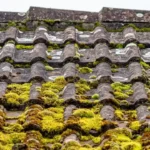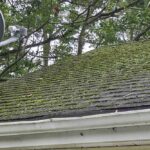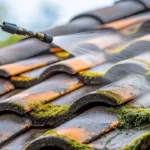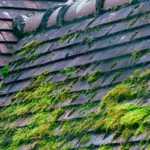Many homeowners living in or near forested areas encounter the common issue of roof moss. This particular concern is not only about aesthetics; it’s also about maintaining the longevity and integrity of your roof. Within these lush green landscapes, the presence of roof moss can become a persistent problem due to the ideal growing conditions it finds. Homeowners often wonder why their roofs are more susceptible and what they can do about it.

What is Roof Moss?
Roof moss is a type of plant that thrives in damp, shaded environments. It often appears as a green, velvety layer on roofs and can cause significant damage if left untreated. In forested areas, the combination of shade from trees and frequent rain creates perfect conditions for moss growth.
Why is Roof Moss a Problem?
Moss retains moisture, which can lead to roof rot and structural damage over time. As moss grows, it lifts shingles and allows water to seep underneath, leading to leaks and potential water damage inside your home. Additionally, the weight of moss can strain your roof, especially after rain, when the moss is saturated with water.
Impact of Forested Areas on Roof Moss Growth
Forested areas contribute to the rapid growth of roof moss due to several factors:
- Shaded Conditions: Trees around your home create shade, reducing sunlight exposure that would otherwise help dry out your roof.
- High Humidity: Forests tend to have higher humidity levels, which are conducive to moss growth.
- Frequent Rainfall: The increased rainfall in forested areas provides the moisture moss needs to thrive.
Preventing Roof Moss in Forested Areas
Prevention is key when it comes to managing roof moss. Here are some effective strategies:
Regular Roof Maintenance
Regular cleaning and maintenance are crucial. This includes removing debris such as leaves and branches that can trap moisture. For more detailed guidance, check out this moss removal guide.
Trim Surrounding Trees
Trimming trees around your home can increase sunlight exposure on your roof, reducing the shade that encourages moss growth.
Install Zinc or Copper Strips
Installing zinc or copper strips along your roof’s ridge can prevent moss growth. When it rains, these metals release particles that kill moss.
Improve Roof Ventilation
Proper roof ventilation can help reduce humidity levels and keep your roof dry, making it less hospitable to moss.
Removing Roof Moss
If moss has already taken hold, its important to act quickly. Here are some removal methods:
Manual Removal
Manually removing moss with a brush can be effective. Be gentle to avoid damaging your shingles. For more tips, visit our DIY budget tips.
Chemical Treatments
Chemical moss removers can also be effective, but its important to choose products that are safe for your roofing material and the environment. Learn more about safe removal methods from IKO’s guide.
Long-Term Solutions for Roof Moss
For homeowners looking for long-term solutions, consider the following:
Roof Replacement
In severe cases, replacing your roof with moss-resistant materials may be the best solution. Modern roofing materials can resist moss and algae growth, offering a more permanent fix.
Professional Roof Cleaning
Hiring professionals for regular roof cleaning ensures that moss is removed safely and effectively. This can also extend the life of your roof.
Conclusion
Managing roof moss in forested areas requires a proactive approach, combining prevention, regular maintenance, and effective removal strategies. By understanding the causes and implementing these solutions, homeowners can protect their roofs from the damaging effects of moss and maintain the beauty and integrity of their homes.

FAQ Section
Q: Can moss damage my roof?
A: Yes, moss can cause damage by holding moisture against the roof, leading to rot and leaks.
Q: How often should I clean my roof?
A: Its recommended to inspect and clean your roof at least once a year, or more frequently in heavily forested areas.
Q: Are there environmentally friendly ways to remove moss?
A: Yes, there are eco-friendly chemical treatments and manual removal methods that are safe for the environment.
This article contains affiliate links. We may earn a commission at no extra cost to you.








